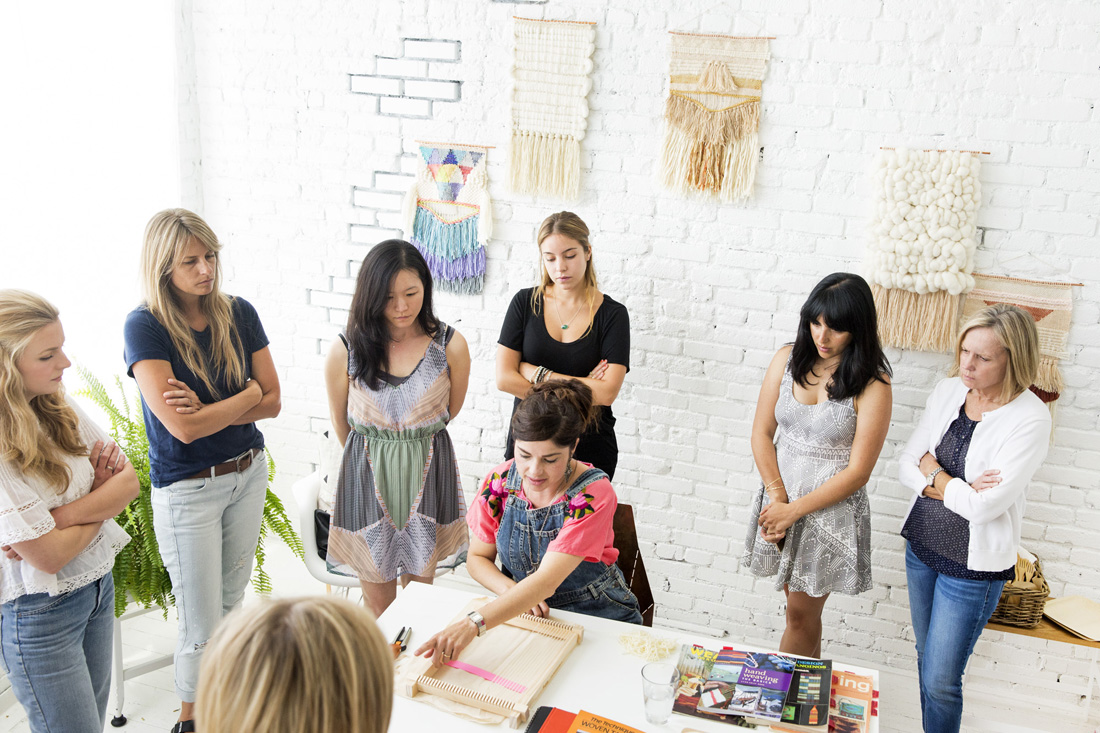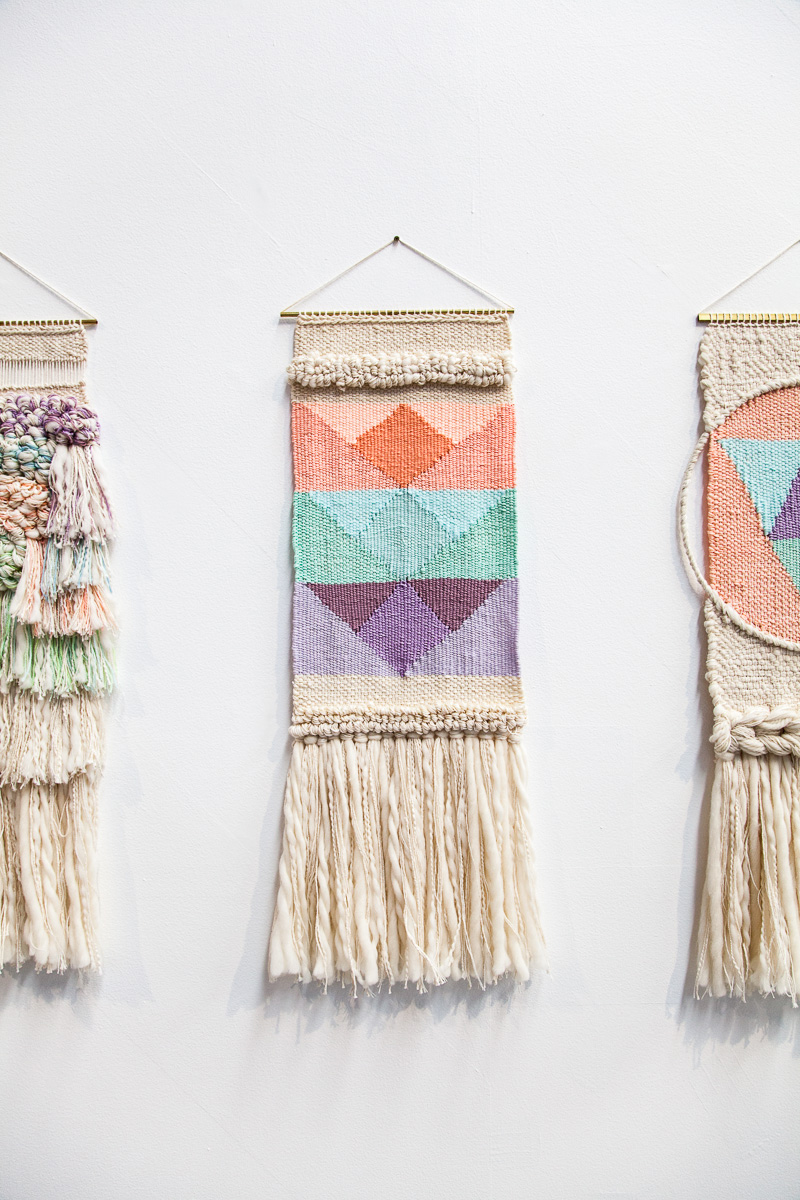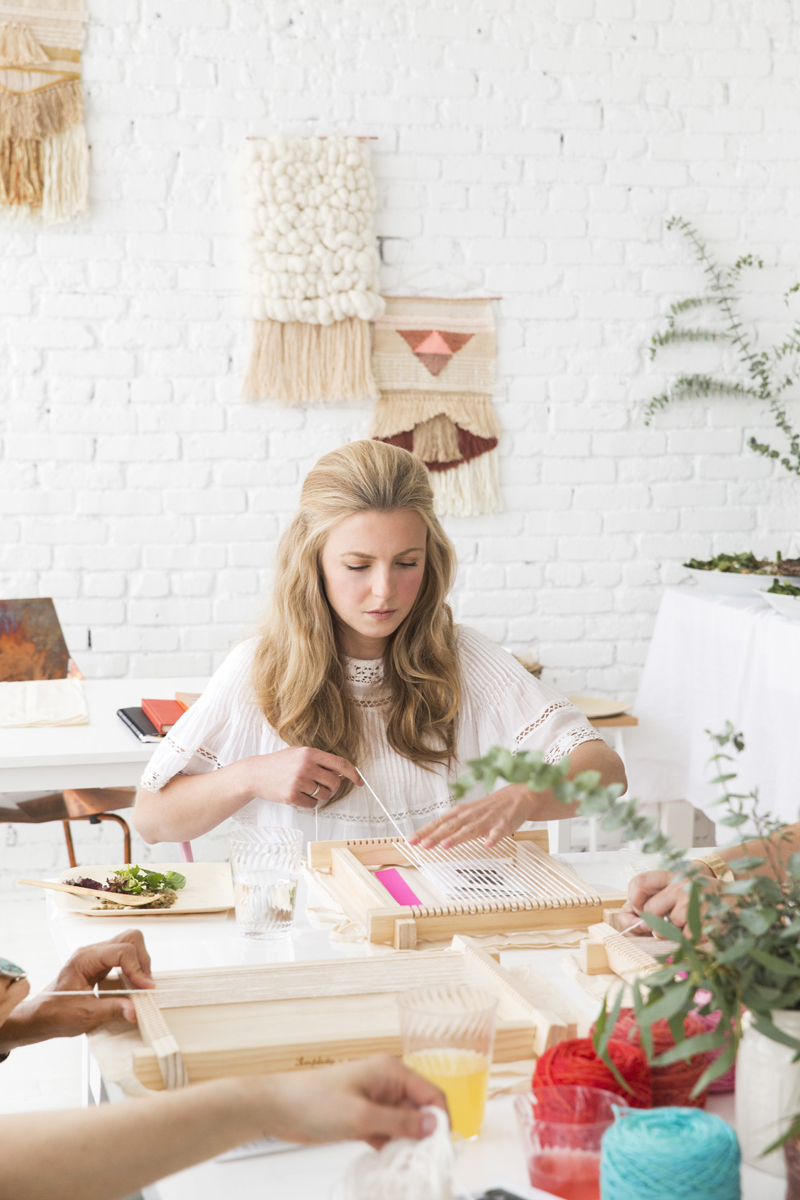
With studio space in New York and a home base in Australia, Maryanne Moodie has quickly become a household name among weaving enthusiasts around the globe. But many may be surprised to realize that the Australian artist who recently published On The Loom: A Modern Weaver’s Guide ($27.50, 144 pages) stumbled across her first loom only about five years ago.
Before she left her job teaching elementary art, Moodie—awaiting the birth of her oldest son—sorted through old art supplies and spotted a box containing a rigid heddle loom from the 1970s. “I didn’t even know what weaving was,” she recalled. But she was intrigued by the contents of the box and took it home. She took out the loom weeks later and decided to give it a whirl. “But then I realized I didn’t have any yarn,” she said. “I wasn’t like that type of crafty person. I had nothing.”
Undeterred, Moodie grabbed the jute and neon wax cord she had on hand and dove into her first weaving project.
“I made two little swatches of fabric to start with and I turned them into a coin purse and a little pencil case,” she said, explaining that she wanted to make her weavings into something useful.
Early on, Moodie focused exclusively on making utilitarian goods to avoid criticism. “As soon as I made something I thought, ‘Well, I’m not going to make art.’ Because if…I give someone some art and I try and tell them to put it on their walls, somebody will say, ‘This is ugly. I’m not putting this on my walls. What are you doing? You haven’t studied art.’” Moodie traces her reluctance to embrace the artist label to her Australian upbringing.
“There will always be someone to bring you back down if you grow too big for your boots,” she says. “Americans are all about ‘be the best you can be’ and…‘let your light shine’, and Australians are like ‘You dim that light down. That’s a little shiny, that light.’” Her next project was making little mats to put on under potted plants. “I still wanted to keep it very useful…. ‘Here’s something to sort of help you in your life so your plants don’t stain your table.’”
Reconciling her desire to make art with her discomfort with calling herself an artist leaves Moodie, 39, feeling a bit conflicted still today. “I still don’t consider myself an artist; I most often think of myself as a maker,” she said. “I’m someone who enjoys making things and because I’m a teacher I totally try to inspire my students—to look at their work as art and themselves as artists, and [to make] an emotional connection between themselves and others. We talk about that whole process of being an artist, and yet I still find it hard within myself.”
At the time she started weaving, Moodie had about 600 Facebook followers. These folks were customers of the web-based vintage clothing business she had been running part-time while she worked as an art teacher and they took a liking to her early weavings.
“Suddenly I was feeling connected with other women and empowered and relevant and creative,” Moodie says about the boost the positive feedback gave her during a time she was feeling a bit isolated staying home with a newborn baby.
After one follower suggested that she try adding rya knots to her tapestries, she Googled the technique and got connected to a group of female tapestry weavers who gave her more tips. They told her she needed to get a frame loom and told her what to warp it with. When her followers started asking to purchase her weavings, her husband, Aaron, suggested she wait a year to start selling and aim to deliver the quality required to sell work in an art museum gift shop.
Moodie agreed that holding off on sales was sage advice, and she started studying vintage weaving books and giving her art away to friends. Instead of soliciting commissioned installation work, she approached local businesses about creating pieces to display in their shops for free. Moodie’s patience paid off in 2013 when her Instagram feed caught the eye of popular Australian style blog The Design Files.


After the post was published, Moodie started fielding a steady stream of requests for tapestries and also got an invitation to teach others how to weave. These opportunities became the foundation of her weaving business that blossomed when Aaron accepted a tech job at Etsy, and the family moved to Brooklyn, which they called home until a couple of months ago. After Etsy’s rapid expansion from roughly 200 employees to more than 1,000, Moodie said she and her husband decided the time was right to move back to Australia to raise their sons. “It was never going to be permanent,” Moodie says about their time in the U.S. “We want them to go to school in Australia and grow up as Aussies.”
While Moodie now resides in Melbourne, Australia, she still has a studio in Brooklyn and plans to fly in several times a year to teach in the US. Her three part-time studio employees fill Etsy orders for looms, kits, and yarn. Right now, the New York studio staff is working to source independent local yarn suppliers as the demand for Moodie’s kits continues to increase. Moodie says she’s also interested in wholesaling the custom-made looms she sources, along with other products, to level out monthly income that sometimes fluctuates dramatically with a mix of teaching gigs, tapestry sales, and supply orders. She also generates revenue from paid video tutorials she offers on her website for those who can’t attend her in-person workshops.
With four years of motherhood under her belt, Moodie is happy to be putting her art teacher skills to use at home. Recently her oldest son requested a custom “getting dressed badge” before returning to his room to get dressed all by himself. Together they crafted a badge using gold leaf and pinking shears, among other supplies. “I don’t miss traditional teaching at all,” Moodie says, admitting that she does miss the steady paycheck. But the upside is having the freedom to spend her days as she chooses, which often involves chasing after her rambunctious boys and weaving about 25 hours a week. “I love how flexible my life is, and I feel totally in control.”
Tune in to the CraftSanity Podcast to hear more about Maryanne Moodie’s story.
Business tips from Maryanne Moodie
Don’t feel obligated to reply to every comment left on your social media platforms. Most small business owners like to feel connected to their audience, but there comes a point when replying to all social media becomes unmanageable. “There was a bittersweet moment around 2,600 followers when I realized I was looking at my phone too much,” Moodie said, recalling how she would sneak glances at her phone while she pushed her oldest son on the swings or while he was drawing. “I just had to let that go. I still read every comment, but I don’t have enough time in the day to respond to everybody.” And guess what? Putting her family first didn’t stunt her social media growth at all. She now has more than 100,000 followers on Instagram.
Don’t be afraid to work for free (for a bit). While getting paid for your work is a fair and reasonable expectation, Moodie believes in the value of being generous while you’re learning the ropes. “Don’t try to sell your first piece,” Moodie said. “Give your work away because…it’s going to give you a great feeling to see it out in the world rather than in a box in your studio being sad.” And if you give your first creations to friends you will be able to see how they hold up, and your friends can give you honest feedback about what you can improve.
Listen to your community and ask questions. While Moodie doesn’t have time to respond to every comment, she reads them and values the feedback. “Don’t just try to put something on Etsy for $25 and then have your heart broken that nobody is even noticing that it’s there or that nobody wants it,” Moodie said. “Because really, if you just changed the color from purple to mustard, people would have wanted it. But how are you supposed to know that? You have [to ask] your community what they want…. Not just online. Ask the people in your life as well: ‘What do you think of this? How can I improve it?’ ”

Jennifer Ackerman-Haywood
contributor
Jennifer is a journalist, podcaster, printmaker, fiber artist, swimmer and community college media adviser. She is also the editor and publisher of CraftSanity Magazine and has produced a podcast about art and craft by the same name since 2006. She blogs at CraftSanity.com, sells her handprinted t-shirts and wooden CraftSanity weaving looms at craftsanity.etsy.com. Jennifer lives in suburban Grand Rapids, Mich., with her husband and two daughters. Follow her fitness and creative adventures on Twitter and Instagram under the name @CraftSanity. Watch her craft tutorials on the CraftSanity YouTube Channel. Contact her by writing jennifer@craftsanity.com.

I can absolutely attest to that different in America and Australia being an inhibitor in believing in/promoting myself! I’ve always said that being an Australian woman has had a “natural” handicap in my confidence at marketting myself – as women we tend to not speak ourselves up, and especially so being Australian. That Tall Poppy Syndrome is a big, subconscious thing we must fight through!
Thanks for sharing Maryanne’s story, it’s lovely to meet a fellow Melbourne maker/artist 😉